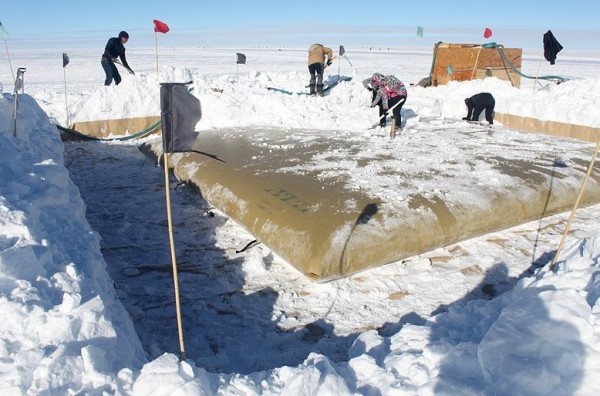Study: Climate Changes in Arctic and Antarctic are Linked to Each Other
| Ana Verayo | | Apr 30, 2015 07:33 AM EDT |
(Photo : Wikimedia) Ice cores from the WAIS Divide reveals evidence for climate changes in both north and south poles.
New research reveals that recent climate and weather changes occurring in the Arctic are apparently also linked to Antarctica.
A research team from Montana State University conducted a comparison of ice cores from the northern and southern polar regions where they discovered temperature spikes and changes from the North Pole had a significant influence on the temperatures found in the South Pole.
Like Us on Facebook
The findings also reveal that climate change effects first appeared in the Arctic and then spread throughout the Antarctic.
According to polar ecologist John Priscu, this issue is pivotal to be able to understand the oscillation between climates on the north and south poles. This type of data can provide scientists a new perspective about global climate change and its dynamics that can help in the assessment of climate regimes in the future.
The team decided to choose ice core sasmples from West Antarctica from a region known as the WAIS Divide due to its thick ice, regular ice flow and amount of annual snowfall.
The team reports that when snow falls on the WAIS Divide, it does not melt but builds up gradually into thick annual layers that are compressed into ice by subsequent snowfall. This compact snow apparently contains dust and microbes including chemicals and atmospheric gases that are trapped inside the ice.
These elements and pollutants can indicate past climate that are contained inside air bubbles which are considered to be samples from Earth's ancient atmosphere. Researchers also say that the deeper ice is older and more ancient that can provide measurements originating from climate in the past.
The ice core samples taken from the site were 4.8 inches in diameter and measures 11,200 feet long. Findings reveal that the ice core from the northern hemisphere suggest that the climate in Greenland was unstable in the last ice age where it underwent dramatic temperature changes. Scientists call this event as Dansgaard-Oeschger events which happened during a few thousand years ago that lasted for decades.
However, temperature in Antarctica showed that it had an opposite pattern where temperatures are getting colder as Greenland heats up. Scientists also believe that these changes spawned from the Greenland region.
In the past, temperature changes were different since they were triggered by the collapse of ice sheets, now, these abrupt climate and temperature changes in the polar regions are caused by increasing levels of carbon dioxide in the atmosphere.
This study is published the journal, Nature.
TagsWAIS Divide, antarctic arctic climate changes linked, Arctic, Antarctic, ice cores arctic antarctic, global warming, polar regions
©2015 Chinatopix All rights reserved. Do not reproduce without permission
EDITOR'S PICKS
-

Did the Trump administration just announce plans for a trade war with ‘hostile’ China and Russia?
-

US Senate passes Taiwan travel bill slammed by China
-

As Yan Sihong’s family grieves, here are other Chinese students who went missing abroad. Some have never been found
-

Beijing blasts Western critics who ‘smear China’ with the term sharp power
-

China Envoy Seeks to Defuse Tensions With U.S. as a Trade War Brews
-

Singapore's Deputy PM Provides Bitcoin Vote of Confidence Amid China's Blanket Bans
-

China warns investors over risks in overseas virtual currency trading
-

Chinese government most trustworthy: survey
-

Kashima Antlers On Course For Back-To-Back Titles
MOST POPULAR
LATEST NEWS
Zhou Yongkang: China's Former Security Chief Sentenced to Life in Prison

China's former Chief of the Ministry of Public Security, Zhou Yongkang, has been given a life sentence after he was found guilty of abusing his office, bribery and deliberately ... Full Article
TRENDING STORY

China Pork Prices Expected to Stabilize As The Supplies Recover

Elephone P9000 Smartphone is now on Sale on Amazon India

There's a Big Chance Cliffhangers Won't Still Be Resolved When Grey's Anatomy Season 13 Returns

Supreme Court Ruled on Samsung vs Apple Dispute for Patent Infringement

Microsoft Surface Pro 5 Rumors and Release Date: What is the Latest?










